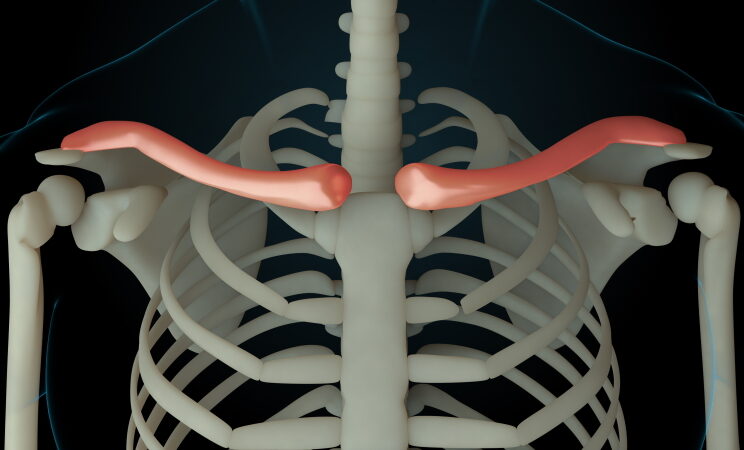The collarbone, also known as the clavicle, connects the shoulder with the chest wall or sternum. Collarbone pain can be caused by an injury such as a fall or can occur gradually. So, what causes clavicle pain, and how do we treat it?
Causes of collarbone pain
The most common cause of collarbone pain is an acute injury to the collarbone or clavicle. However, pain around the collarbone can also originate from tissues away from the clavicle, such as the chest or abdomen.
Trauma causing collarbone pain
During a fall or a collision, forces are transmitted directly to the middle and ends of the collarbone. These large forces cause a break in the bone or dislocation of joints at the end of the bone.
Fractured collarbone
A broken clavicle makes up about 5% of all fractures in adults. Generally, a break is felt immediately, causing severe pain and swelling in the collarbone. Usually, a simple X-ray can detect a break. Treatment depends on whether the crack occurs in the middle or the ends and how separated the two ends of the break are. Generally, breaks in the middle of the clavicle with less separation are treated with a simple sling. Alternatively, cracks at the ends with greater separation may require surgery.
Dislocated AC joint
The AC joint connects the collarbone with the shoulder. A fall onto the tip of the shoulder or on an outstretched hand can cause the ends to pull apart, leading to a dislocated AC joint. A dislocation produces pain, swelling, and a visible lump on top of the shoulder.
An X-ray will help confirm an AC joint dislocation and rule out a collarbone break. Treatment usually depends on the grade of the dislocated AC joint. For example, we treat a grade 1-2 AC dislocation with physiotherapy, while grades three and above will need surgery.
Rib fracture causing collarbone pain
Less commonly, a fall or direct trauma can fracture a rib close to the collarbone. Generally, people report sudden pain and swelling below the collarbone. The pain is sharp and worsens with breathing or coughing.
Non-trauamtic collarbone pain
Generally, pain in the collarbone without a fall is due to joint arthritis or excessive training such as gym or sports.
AC joint arthritis
As we age, the AC joint is at risk of developing arthritis. When combined with excessive activity, arthritis can cause joint inflammation and pain at the outer end of the collarbone. Generally, treatment of AC joint arthritis consists of NSAID tablets such as ibuprofen, physiotherapy, and occasionally a cortisone injection.
Sternoclavicular joint arthritis
Sternoclavicular joint arthritis is less common than AC joint arthritis. This joint joins the collarbone with the middle of the chest wall, also called the sternum. Usually, people report pain and swelling near the top of the sternum at the bottom of the neck. Treatment is the same as for AC joint arthritis: NSAID tablets, physiotherapy, and sometimes a cortisone injection.
Distal clavicular osteolysis

Weightlifters or bodybuilders place a high load on the collarbone. This increased load can lead to excessive stress and swelling outside the collarbone. This condition is called distal clavicular osteolysis or weightlifter’s shoulder. We treat this condition with rest from heavy weights, physiotherapy, and NSAIDs. Occasionally, we use a cortisone injection to help healing.
Stress Fracture of the rib
Overload of the chest wall can lead to microtrauma to the ribs, leading to fatigue and bone breakdown. Rib stress fractures are more common in particular sportspeople such as rowers.
Referred pain
Inflammation of the abdomen, such as gallstones or appendicitis, can trigger pain in other body parts. One of the more common areas of referred pain from abdominal inflammation is the outer end of the collarbone. Heart pain can also be felt in the neck, close to the collarbone.
Treatment of collarbone pain
In general, the treatment of collarbone pain depends on the specific cause. History can explain whether the pain is secondary to trauma or overuse. Often, there is a painful collarbone lump that is tender to touch. The position of the painful collarbone lump gives a clue to the diagnosis.
Usually, we suggest an X-ray if we think the pain is coming from the collarbone. In some cases, an MRI or bone scan may help determine the cause.
Final word from Sportdoctorlondon about collarbone pain
Overall, collarbone pain is primarily due to a fall, making the diagnosis straightforward. However, the diagnosis can be a little more complicated in cases without trauma. We suggest you see a doctor experienced in musculoskeletal injuries to get the correct diagnosis.
Related topics on collarbone pain:
- Distal clavicular osteolysis
- AC joint arthritis
- Shoulder blade pain
- Shoulder pain map
- Sternoclavicular joint arthritis
- Rib stress fracture


Leave A Comment